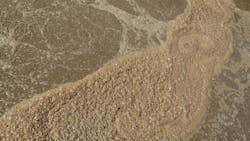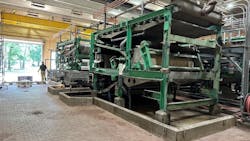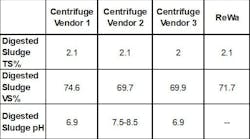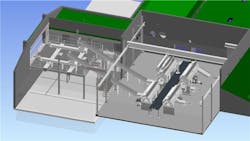The state of municipal wastewater sludge mechanical dewatering in North America
Municipal sludge dewatering technologies are an essential aspect of wastewater solids management in reducing the overall volume of sludge, making it easier to handle, transport, and dispose. Solids disposal cost is typically a significant cost (10% to 30%) of a wastewater utility’s annual budget.
The most widely adopted mechanical dewatering technologies for liquid/solids separation in North America include centrifuges, belt filter presses (BFPs), screw and volute presses, and fan presses. Each of these technologies has their applicability in the municipal sludge dewatering market and unique characteristics, advantages, and disadvantages for varied sludge dewatering applications.
Dewatering performance will vary between sludges even within municipal wastewater treatments, and each technology will vary in performance between unstabilized and stabilized (aerobically digested, anaerobically digested) sludges.
Introduction of technologies
Centrifuge
A centrifuge uses centrifugal force to separate water from sludge solids typically in the range of 2,000 to 4,000 G’s (a function of rotational speed, rpms, to produce the gravitational force require to facilitate liquid/solids separation).
Sludge is fed into a rotating drum where an outer bowl and inner scroll rotate in the same direction at a differential speed to promote liquid/solids separation. Polymer or other coagulating chemicals are added to the liquid sludge to aid in coagulation of the solid particles. The rapid spinning generates centrifugal forces causing heavier particles to move outward and toward a narrowing cone within the centrifuge conveyed by a screw on the scroll.
The coagulated solid particles build up in the cone end of the centrifuge and are then discharged as a dewatered cake product.
Belt filter press
Sludge is conditioned with polymer or other coagulating chemicals and fed onto a moving belt typically constructed of a polymer composite material.
The belt generally consists of two sections, initially utilizing gravity to cause separation of free water from the sludge particles and later passes the thickened sludge through a series of rollers along with a second belt that applies pressure to squeeze out water. The dewatered sludge forms a cake collected at the end of the process.
The belts are continuously cleaned with wash water sprayed from the belt's interior before returning to contact with incoming sludge. The water extracted during dewatering of sludge passes through the belt and is typically referred to as filtrate.
Screw and volute presses
Screw and volute presses (sometimes referred to interchangeably) operate similarly with a few key distinctions.
Both technologies utilize a series of stages (flocculating, thickening, dewatering) to dewater municipal sludge forming a dewatered cake. The first stage flocculates the sludge in a tank where liquid sludge and polymer are gently mixed to form large flocs prior to entering the press.
Screw presses use a slow-moving screw auger with angled flights of a specific pitch to convey the sludge through a cylindrical perforated plate or wedge-wire section that allows for the separation of the free water from the sludge particles. As the sludge travels through the screw press, the auger flights become closer together, and the perforated openings in the cylinder become smaller resulting in increased operating pressure for effective liquid/solid separation. Brushes and/or wash water outside of the perforated plate or wedge-wire sections are used to intermittently clean off the orifices the extracted water passes through while the unit is in operation.
A volute press also utilizes an internal screw auger to convey the sludge. However, the key distinction is the use of a dewatering drum with fixed and moving cylindrical plates in lieu of a perforated plate cylinder used in a screw press. The innovate approach of fixed and moving plates in a volute press typically requires less wash water compared to a traditional screw press.
Rotary (fan) press
Sludge is fed at low pressure into a channel where it rotates between two parallel filtering elements. Rotary presses are modular with the ability to add additional filtering elements.
The filter plates (perforated discs) slowly rotate against each other conveying the sludge towards an exit point. Scrapper blades continuously clean the filter plates during the dewatering process reducing the need for wash water. As the sludge moves through the channel, water is gradually expelled, forming a dewatered cake. The process is continuous and automated.
Municipal sludge dewatering technology key design, performance and O&M considerations
The dewatering technologies summarized in the section above are considered established technologies in the industry. They are all capable of high solids capture (>95%) and can produce a dewatered cake product typically ranging between 15 to 30% dry solids.
The criteria for dewatering technology selection for a wastewater treatment facility is a function of a variety of factors including desired dewatering performance criteria, sludge characteristics, utility (power, wash water) requirements, operation and maintenance (O&M) considerations, and available space.
Prior to selection and implementation of a dewatering technology at a wastewater treatment facility, pilot and bench scale testing of dewatering technologies is recommended as dewatering performance and other factors can be site and sludge specific. Pilot scale, typically trailer mounted units, can be deployed at sites for longer durations to further evaluate impacts in performance due to sludge and seasonal variability. They also serve as useful tools for plant staff to build O&M knowledge and familiarity of a new technology.
For all dewatering technologies, the separated water, typically referred to as centrate or filtrate, is returned to the mainstream liquid process. Pretreatment of this water due to high organic and nutrient loads may be required if the mainstream liquid treatment process is challenged to treat the additional solids and nutrient loads. The need for side stream treatment of centrate/filtrate may require closer consideration for anaerobically digested sludges.
The following table provides a summary of some of the key operational and maintenance considerations for each of the dewatering technologies discussed.
Table 1 dewatering technology O&M considerations
Case study: ReWa Mauldin Road WRRF dewatering upgrade
The transition to full time dewatering of anaerobically digested sludge at the ReWa Mauldin Road Wastewater Resource Recovery Facility (29 MGD annual average monthly flow) necessitated careful planning and consideration of key design and operational factors.
Previous pilot scale evaluations supported replacing the plant’s aging belt filter presses, which are currently only used periodically when liquid land application is not viable. Facility leaders chose centrifuges to meet ReWa’s near and long-term biosolids handling needs as it transitions to full time sludge dewatering, which allows for greater operational flexibility in its biosolids management strategy.
The plant currently operates at an average daily flow of 15 MGD with a daily average anaerobically digested sludge production volume of approximately 19,000 dry lbs/day (31,000 dry lbs/day max 15-day) with an average total solids content of 2%. As the plant approaches the build-out capacity of 29 MGD, daily average sludge production will increase to approximately 30,000 dry lbs/day (47,000 dry lbs/day max 15-day) assuming the characteristics of the sludge are not changing over time.
Major considerations for the upgrade include sizing the centrifuges to meet current and future sludge production volumes, desired operating schedules, providing improved solids storage upstream of dewatering, physical space inside the existing dewatering building, centrate collection and conveyance, utility water demands, dewatered cake conveyance, electrical and building mechanical upgrades to meet current code compliance, and provisions for additional expansion in the future.
The design team worked with multiple centrifuge manufacturers to complete bench scale tests of digested sludge samples to evaluate and validate anticipated digested sludge feed characteristics, dewatering performance, polymer demand, and centrifuge model selection. Samples of digested sludge as well as thickening and dewatering polymers currently used at the plant were sent for analysis.
Some of the vendors also tested additional polymers as part of their analysis. The following tables summarizes the bench scale performance data completed by three separate centrifuge vendors. As summarized in Table 3, anticipated performance can vary across polymer types and even equipment manufacturers.
Table 2 centrifuge bench scale sludge characterization
Table 3 centrifuge bench scale polymer demand and dewatering performance analysis
Additionally, as this facility biologically removes phosphorus, orthophosphate (OP) sampling was completed as higher OP concentrations (typically >500 mg/L) in the sludge and centrate can potentially impact dewatering efficiency and/or liquid stream processes leading to struvite formation and buildup.
The sampling data is summarized in the table below and generally shows OP sample concentrations were generally within acceptable limits for efficient dewatering performance. Further evaluations on any potential liquid stream performance impacts are still ongoing.
Table 4 Mauldin Road sludge orthophosphate sampling results
Workshops with ReWa staff to review design criteria, equipment layouts, operating parameters, construction sequencing, and building code requirements were beneficial in streamlining design decisions. Design of the upgrades to the dewatering facility are underway, with construction anticipated to be completed in 2027/2028.
Utility considerations
Costs for biosolids management across the US are rising due to increase in trucking, land application and landfill disposal costs. It is prudent wastewater utilities consider solids dewatering, and if implemented, operate it optimally to maximize mass and volume reduction for off-site transport. Dewatering can also help utilities with long term storage (days, long weekend), if necessary, and build in flexibility with biosolids management. The dewatering technologies discussed herein are widely adopted across the United States.
Several factors including sludge characteristics, costs, utility requirements and O&M preferences plays a role in selecting the appropriate dewatering technology. There is no one size or technology that fits all. It is recommended bench and pilot scale testing is considered to aid in decision-making and selecting the most appropriate dewatering technology.






